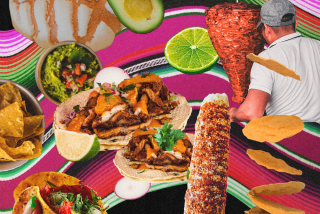Spoons and the Men Who Love Them
- Share via
“You can eat anything with a spoon,” says my husband. And so he does.
He is--in most respects--responsible and housebroken. He grew up with pleasant parents in a pleasant Philadelphia neighborhood, with Royal Copenhagen flatware, Spode china, even servants now and then. He’s good at thank-you notes. He knows how to dress for funerals, cathedrals and saloons. He goes at many of life’s problems with an easy charm.
But there is the refractory matter of the spoon. He prefers it to the fork. He eats baked potatoes with it. Salad. Chicken. Pancakes and pie and lamb chops. And stir-fry and asparagus.
And not just any spoon. He has a favorite spoon--an only spoon, really, one that has been with him through good meals and bad over the past 20 years. On days when my husband can’t find his spoon, everything comes to a sullen halt. “The spoon. Where’s the spoon?”
No heirloom silver spoon, this one. It’s nothing but a machine-punched, stainless-steel mess-kit model, the picture of cheap, bought as part of his gear for a Georgia-to-Maine hike up the Appalachian Trail long ago.
Since then, “The Spoon” has gone with him into Afghanistan on hairy monthlong reportorial foot travels with the mujahideen, to the cook-fires of Nicaragua with both the Sandinistas and the Contras. It’s been applied to food you could get down but wouldn’t want to step in: rank goat meat, fish heads, fugitive pig parts, fermented mush, raw monkey brains, dog on a spit, torrents of rice slicked with water-buffalo grease.
On a reporting trip to Eritrea, The Spoon got soaked with the iodine crystals my husband used for purifying water, and the chemicals pitted it to an unsightly, ulcerated finish. When I found The Spoon looking thus in a kitchen drawer one morning, I tossed it into the garbage, only to dig it out again in the face of his dark objections.
“It just feels right in my hand. It’s a wonderful spoon.”
Margaret Visser understands The Spoon. “Spoons can inspire affection as knives and forks cannot,” she writes. “They are unthreatening, nurturing objects.” But, she points out: “Insofar as spoons have an infantile image, they lack prestige.” More importantly, Visser leaves you with the conviction that the fork is one of the great advances of the human race.
It took Europe eight centuries, Visser writes, to cotton to the fork. But once it caught on, the fork brought sweeping social adjustments along with it. New gestures, which kept people from attacking their food with their fingers. New postures, which kept them from brushing against each other while bent over their slops.
Forks, she says, were instrumental in the great human migration off the bed-like dining couches of ancient Greece and Rome, and onto the modern-day chair. They helped restrict our possibilities among the 132 main ways of sitting that Visser says anthropologists can identify. Forks gave us new body language. They heralded the sense of an inviolable personal space that so marks Western life today.
“Forks have placed us in a singularly distant relationship vis-a-vis our food,” writes Visser, “and, more importantly, they both express and influence our self-enclosed, fastidious attitude toward the people with whom we eat.”
Visser’s exhaustive research on the spoon has even unearthed a Freudian analysis of silverware, one that, she reports, “gives the spoon the female role in the (flatware) trio.
“The fork, if I understand the writer correctly, is the male child of the knife and spoon, and, like a little Oedipus, is resentful of the knife and jealous of the spoon.”
My husband just says it’s the only way to go--on the couch or off.
More to Read
Eat your way across L.A.
Get our weekly Tasting Notes newsletter for reviews, news and more.
You may occasionally receive promotional content from the Los Angeles Times.








